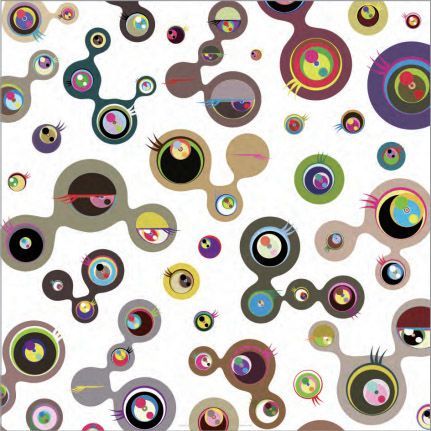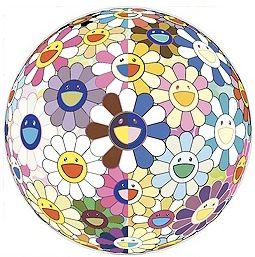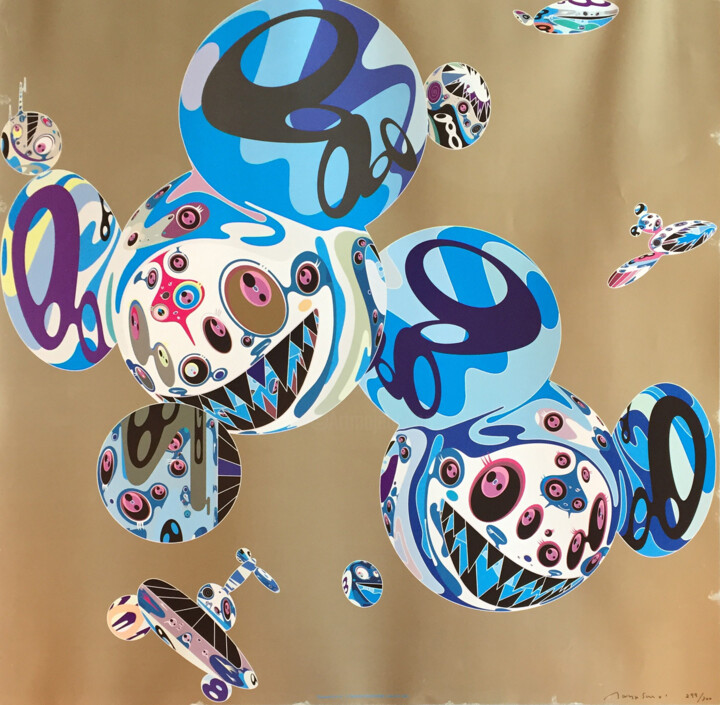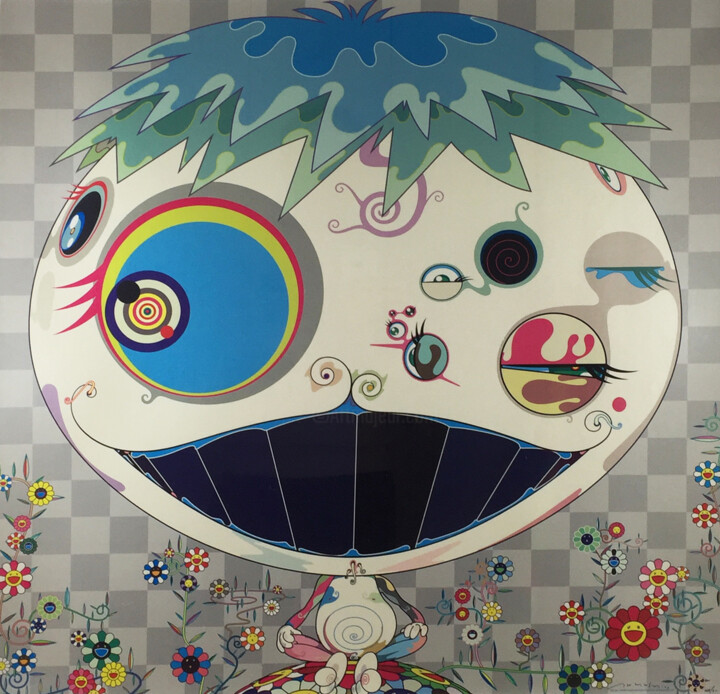Takashi Murakami @takashipom
Artist Takashi Murakami
Takashi Murakami, hailed by Time magazine as the foremost ambassador of Japanese culture, stands as one of the renowned artists in the global art realm at present. His creations unmistakably reflect the motifs and distinctive stylistic elements commonly found in Japanese iconography, making them quintessential symbols of Japanese society. Murakami's artistic expressions span various forms, encompassing cartoons, minimalist sculptures, and merchandise adorned with his iconic character, Mr. DOB.
Born into a modest Japanese family in 1962, Takashi Murakami found his passion for drawing driving him to pursue an education at the National and Fine Arts and Music University in Tokyo. Despite his initial desire to become a manga artist, he found himself studying Nihon-ga art, which adhered to the conventions of traditional Japanese art. Although this style no longer reflected contemporary Japan, Murakami gained valuable insights from his university studies, which would later influence his distinctive artistic style.
In 1989, he unveiled his inaugural solo exhibition, marking his debut in the art world. Following his graduation, he was granted a fellowship at MoMA PS1 in New York, prompting his relocation to the bustling American metropolis. It was during his time in New York that he encountered Pop Art and the works of Andy Warhol, leaving an indelible impact on his artistic vision. Murakami masterfully fused art and consumerism, transforming them into tangible creations with significant cultural value, often fetching high prices in the art market.
However, Murakami's artistic exploration did not end with adopting Warhol's Factory concept. He was also captivated by the somewhat flamboyant artworks of Jeff Koons, an iconic figure in neo-pop art who adeptly portrayed the American way of life through his ironic pieces. This period in New York became a turning point in Murakami's art, as he amalgamated the allure of America with his Japanese sensibilities, resulting in works that harmoniously blended Western and Oriental elements.
Confirming the consumerist nature of his art, Takashi Murakami establishes collaborations with influential fashion companies such as Louis Vuitton. In this partnership, he reinterprets the iconic items of the fashion house, creating exclusive pieces that gain admiration from international celebrities like Paris Hilton, Kim Kardashian, and Naomi Campbell. One of his notable successes is the Cherry Blossom bag, which garners immense popularity and commands a price of five thousand dollars. Murakami's artworks possess a remarkable ability to penetrate the market, surpassing all expectations. He fills a void where Pop Art fell short, capturing the masses' desire to possess objects associated with imagination.
Recognizing that people seek a connection to an imaginary world through material possessions, Takashi Murakami purposefully channels his artistic vision in this direction. His aesthetic and entrepreneurial approach enables him to captivate both the general public and the international elite, enticing them with signature products from his art production company, Kaikai Kiki. The value of his artworks is exemplified by notable sales, such as the sculpture "Tongari Kun," purchased by the owner of Christie's in 2003 for $1.5 million, and "My Lonesome Cowboy," which fetched a staggering $15.2 million at a Sotheby's auction in 2008.
However, following the devastating tsunami in 2011, Murakami's art took a transformative turn, embracing a more spiritual and redemptive direction. This shift is evident in his painting titled "In the Land of the Dead, Stepping on the Tail of a Rainbow," where he delves into existential trauma and explores the role of faith in such challenging circumstances. Murakami acknowledges that this event brought about a radical change in his philosophy, leading him to develop a profound respect for how beliefs serve as responses to natural and other adversities.
Top 12 Prices Paid at Auction
Takashi Murakami has played a pivotal role in elevating Japanese Pop Art to a prominent position within the Western art market. This has resulted in a remarkable 10% growth in the average value of Murakami's artworks over the past five years.
Notably, the highest price ever achieved for a Takashi Murakami piece occurred in May 2008. At Sotheby's Contemporary Art Evening Auction in New York, his artwork titled "My Lonesome Cowboy," which drew inspiration from an Andy Warhol film, fetched a staggering US $15.1 million.
The enduring popularity and influence of Murakami have made him a highly coveted artist in the secondary art market. His prints consistently maintain a high value, exemplifying their enduring appeal to collectors and art enthusiasts alike. Below are the artist's most expensive works:
1. £1.9M for Wow, Kaikai Kiki (2010-11)
2. £1.9M for KaiKai Kiki (2005)
3. £2.2M for The Simple Things (2008-09)
4. £2.2M for Panda (2002)
5. £2.2M for Dob In The Strange Forest (Red Dob) (1999)
6. £2.7M for The Castle Of Tin Tin (1998)
7. £3.9M for Tan Tan Bo (2001)
8. £3.9M for 69 Arhats Beneath the Bodhi Tree (2013)
9. £4.2M for Miss KO2 (1997)
10. £4.4M for Red Demon And Blue Demon (2013)
11. £6.4M for Dragon In Clouds - Red Mutation (2010)
12. £7.8M for My Lonesome Cowboy (1998)
10 of the Most Influential Contemporary Artists
10. Joan Cornella
9. Damien Hirst
8. Jeff Koons
7. Cecily Brown
6. Yayoi Kusama
5. Jenny Saville
4. Ai Weiwei
3. Takashi Murakami
2. Jean-Michel Basquiat
1. Bansky
Why invest in Takashi Murakami?
Cultural Ambassador: Takashi Murakami is hailed as a foremost ambassador of Japanese culture, with his artworks reflecting motifs and stylistic elements deeply rooted in Japanese iconography. Investing in his work allows you to embrace and appreciate the essence of Japanese society.
Artistic Range: Murakami's artistic expressions encompass a wide range of mediums, from cartoons to minimalist sculptures and merchandise adorned with his iconic character, Mr. DOB. This diversity offers a breadth of options for collectors, ensuring a varied and compelling portfolio.
Fusion of Traditional and Contemporary: Murakami's background in studying Nihon-ga art and his exposure to Pop Art in New York resulted in a unique fusion of traditional Japanese art conventions with contemporary influences. This blend creates a captivating and innovative artistic style that appeals to both traditional and modern art enthusiasts.
Market Penetration: Murakami's collaborations with influential fashion companies like Louis Vuitton and his ability to create exclusive pieces that resonate with international stars demonstrate his art's consumer appeal. Investing in his work allows you to tap into the market-penetrating power and commercial success associated with his creations.
Record-Breaking Auction Prices: Murakami's artwork has achieved record-breaking prices at prestigious auctions, such as the staggering $15.1 million for "My Lonesome Cowboy" in 2008. These high-value sales reflect the strong demand and enduring value of his art in the market.
Sought-After in the market: Murakami's enduring popularity and influence make his artworks highly sought-after. Investing in his work provides an opportunity to acquire pieces that hold their value and have the potential for appreciation over time.
Aesthetic and Entrepreneurial Approach: Murakami's ability to merge art and consumerism, as well as his entrepreneurial approach through his art, have contributed to his widespread appeal. Investing in his work allows you to engage with an artist who has successfully merged artistic vision with commercial success.
Spiritual and Thought-Provoking Themes: Murakami's art took a transformative turn following the 2011 tsunami, embracing more spiritual and redemptive themes. His exploration of existential trauma and the role of faith in challenging circumstances adds depth and thought-provoking elements to his body of work.
Recognition Among Influential Contemporary Artists: Murakami's standing within the art world is affirmed by his inclusion in lists of the most influential contemporary artists. Being ranked among the top artists alongside names like Basquiat, Koons, and Kusama reinforces his significance and lasting impact.
Long-Term Growth Potential: With the average value of Murakami's artworks experiencing a steady 10% growth over the past five years, investing in his work presents an opportunity for long-term growth and appreciation. The consistent value and ongoing appeal to collectors and art enthusiasts contribute to the potential financial benefits of investing in his art.
Jelly fish (2003)
In Takashi Murakami's 2003 offset lithographic print titled Jelly Fish (2003) a prominent feature is a jellyfish with large eyes situated on a flowery planet. The artwork showcases Murakami's signature style, where vibrant flowers surround the central subject. The jellyfish commands attention with its striking eyes, creating an almost human-like expression that is characteristic of Murakami's playful approach. It exudes a sense of tranquility and ease, finding harmony within its surroundings on the flower-filled planet.
The flower planet itself is depicted with lively patterns, representing the fantastical world crafted by Murakami. The flowers that envelop it are vibrant and exuberant, featuring stylized shapes and vivid colors. This whimsical floral imagery encapsulates the artist's unique aesthetic. Flowers hold significant meaning within Murakami's body of work, frequently appearing as a recurring element in his iconography. They symbolize beauty, nature, and joy, permeating various aspects of his artistic practice. The dynamic and colorful composition of Jelly Fish (2003) embodies Murakami's distinctive style, seamlessly blending elements from popular culture and traditional Japanese art.
Analyzing the jellyfish's (Jelly Fish, 2003) pose and somatic features, it fully falls within Murakami's "manga" style, even finding affinities with earlier and highly successful subjects of the Japanese artist, such as Oval Buddha silver, whose reflective pose it takes on, and Tan Tan Bo, a character from whom it inherits several physical characteristics. Nevertheless, Jelly fish's multiple eyes appear to be somewhat independent of tradition, as well as able to have anticipated the creation Jellyfish Eyes, a series of prints, which, while light and whimsical in appearance, actually capture the essence of the concept of misunderstanding.
In fact, they probably refer to the plot of Murakami's children's film Jellyfish Eyes (2013), aimed at telling the story of Masashi, or a young Japanese man, who develops a friendship with a jellyfish-like creature while mourning the loss of his father. Precisely the misunderstanding emerges when we realize, that, behind the design of a cute jellyfish, there is actually a narrative ready to evoke about the victims of disasters, especially in response to the earthquake and tsunami that had struck Japan.
Finally, briefly describing Oval Buddha and Tan Tan Bo, the former delights our perception with its glossy surface, in which its central figure seeks the ever elusive nirvana, while the latter is an icon of Takashi Murakami's work, as it reincarnates the more popular figure of Mr. DOB, a character portraying a sharp-toothed but playful figure whose name is derived from the Japanese slang phrase "dobojite" or "why?" This question reflects Murakami's dissenting view of consumer society, which he considers empty and lifeless. In a 2001 retrospective of his work, Murakami also stated that he came up with the anime-inspired mascot after studying the worldwide appeal of famous characters such as Walt Disney's Mickey Mouse.
The aforementioned stylistic affinities, as well as the complex context within which they are linked, allow Jelly fish (2003) to establish itself as a conduit between the Japanese artist's past and present figurative investigation, capable of enduring in its role as a source of inspiration for future creations as well.
Why invest in Jelly fish (2003)?
1. Signature Style: "Jelly Fish" showcases Murakami's distinctive style, with vibrant flowers and a central jellyfish that exemplify his artistic vision.
2. Eye-Catching Subject: The jellyfish's large eyes in "Jelly Fish" command attention, creating a captivating focal point within the artwork.
3. Playful Expression: The almost human-like expression of the jellyfish reflects Murakami's playful approach, adding a whimsical and engaging element to the piece.
4. Lively Patterns: The lively patterns depicted in the flower planet highlight Murakami's fantastical world, adding visual interest and dynamic energy to the artwork.
5. Symbolism of Flowers: Flowers hold significant meaning in Murakami's work, representing beauty, nature, and joy, which adds depth and layers of interpretation to the piece.
6. Blend of Tradition and Pop Culture: "Jelly Fish" seamlessly combines elements of traditional Japanese art with popular culture references, showcasing Murakami's ability to merge different artistic influences.
7. Narrative Potential: The artwork's connection to Murakami's film "Jellyfish Eyes" suggests a deeper narrative and conceptual depth, offering intriguing storytelling possibilities.
8. Artistic Legacy: "Jelly Fish" represents a bridge between Murakami's past and present artistic explorations, making it a valuable piece that contributes to his enduring legacy and potential future inspirations.

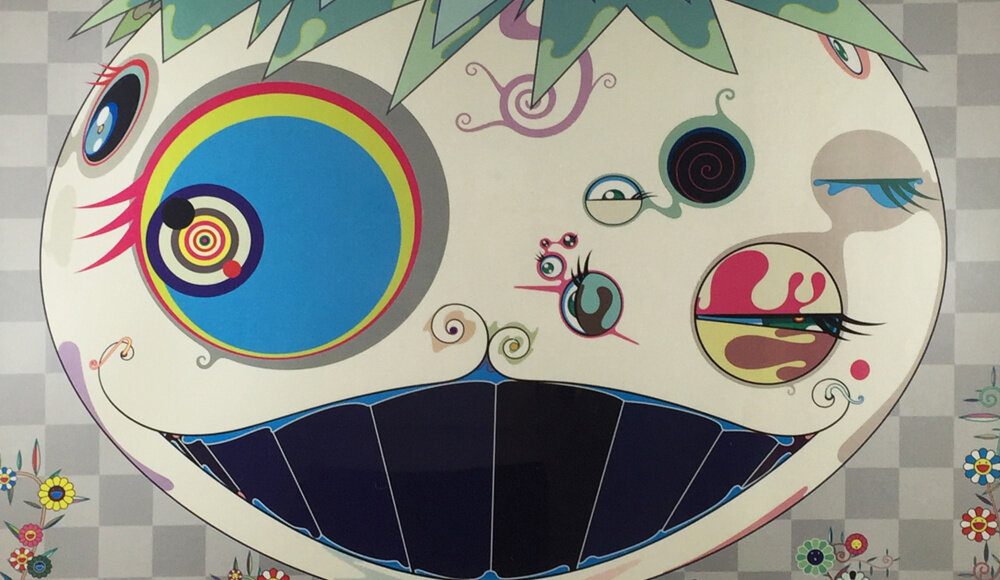

 Olimpia Gaia Martinelli
Olimpia Gaia Martinelli

